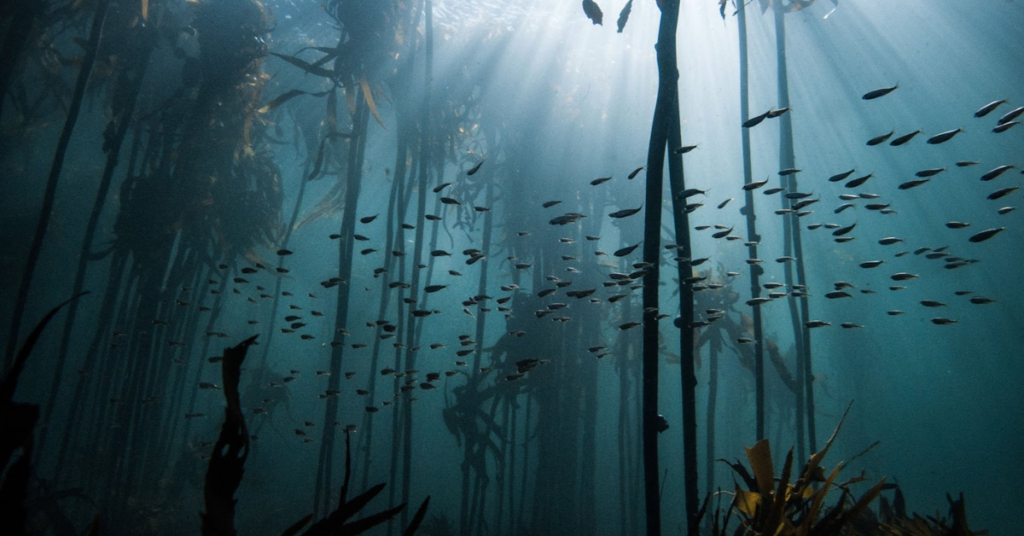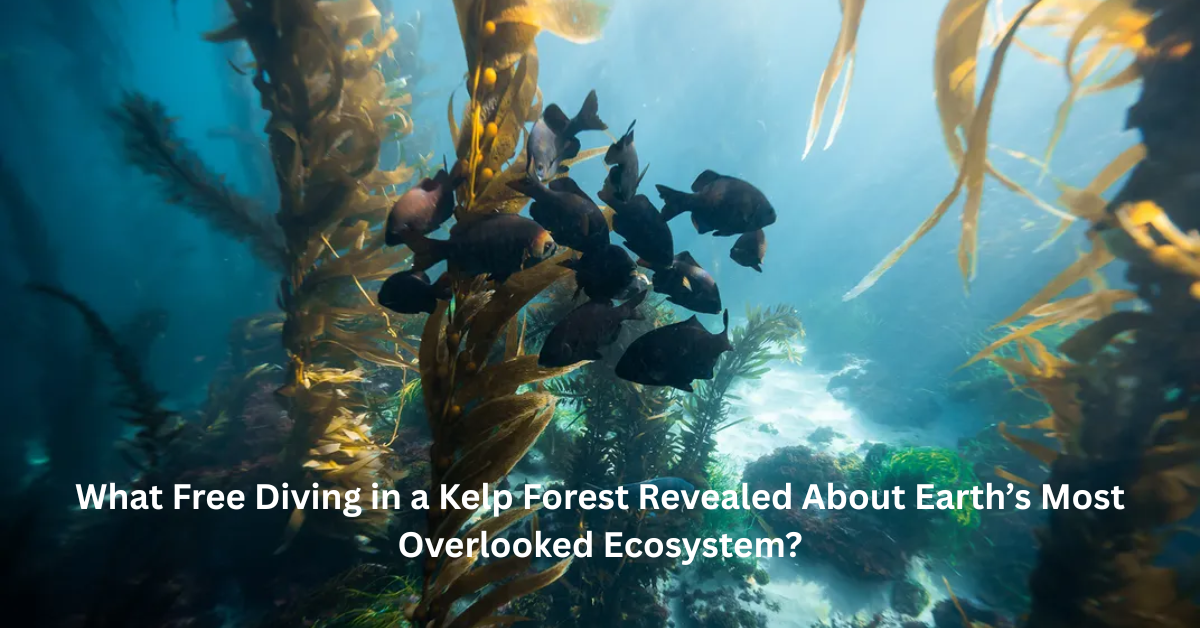There’s something uniquely mesmerizing about the kelp forest. Situated along the coasts, these lush, underwater jungles hold a rare beauty, filled with life that moves through them like clockwork. For three years, I’ve been diving into the clear waters off the California coast, spending hours exploring the magical underwater world that surrounds these towering forests of kelp.
What started as a simple dive turned into an ongoing love affair, where I capture each shift in this underwater world, letting my camera serve as a bridge between this thriving ecosystem and the outside world.
The kelp forest is dynamic—one moment, you’re gliding through clear waters bathed in golden sunlight, the next, a wave has stirred up the sea, turning everything dark and wild. The tops of these kelp plants can rise like trees from the ocean floor, creating towering columns that sway with the current. As I dive deeper, my senses seem to sharpen, and it feels as if I’m in a living, breathing masterpiece.
The kelp’s leaves shimmer with golden light, fish dart in and out, and sea lions zip through the water with effortless grace. With my camera, I strive to capture those fleeting moments, freezing a scene that would otherwise pass unnoticed. For me, photography isn’t about creating distance; it’s about creating presence. It forces me to look deeper and be more attuned to my surroundings, fulfilling the advice of poet Mary Oliver: “Pay attention. Be astonished. Tell about it.”
But while I can capture a moment, the kelp forest is constantly changing. These ecosystems are wild in a way few places are anymore. They face challenges and uncertainties, yet their beauty and importance remain. And for me, returning time and again to the kelp forest isn’t just about witnessing this change—it’s about learning from it, understanding the delicate balance that sustains it, and realising just how much these ecosystems contribute to our planet.
The Vital Role of Kelp Forests
Kelp forests are some of the most productive ecosystems on Earth. Giant kelp, a type of algae, grows rapidly—up to 18 inches per day—and can reach over 100 feet in height. These underwater “trees” create a three-dimensional habitat, providing shelter and food for a wide variety of marine life. They also play a critical role in mitigating climate change by absorbing carbon from the atmosphere and storing it. Kelp forests buffer coastlines from the battering force of waves, reducing coastal erosion and helping to maintain the natural balance of the ecosystem.
But despite their immense value, kelp forests are under threat. Over the past 50 years, kelp abundance has declined globally at a rate of 1.8% annually. About 40-60% of the world’s kelp forests have been degraded, with many in a perilous state. The situation is particularly dire along the California coast, where the loss of kelp has reached alarming levels. Some areas have experienced a 90% reduction in kelp coverage over the last decade.
Kelp faces several challenges that threaten its survival. Rising ocean temperatures are weakening kelp, reducing its ability to reproduce and grow. Meanwhile, unchecked sea urchins, which feed on kelp, are wreaking havoc on the forests. Nutrient pollution from agricultural runoff is clouding the water, blocking sunlight essential for kelp’s photosynthesis. And algal blooms, fed by excess nutrients, can smother and suffocate the kelp.
Six Life-Changing Lessons from the Kelp Forest
The kelp forest is a place of awe and wonder, but it’s also a source of valuable lessons. Each dive teaches me something new, not just about the ecosystem but also about the importance of conservation. Here are six powerful lessons I’ve learned from my experiences.
Every Creature Matters
When you dive into the kelp forest, it feels like the entire ecosystem is breathing in unison. Fish swim in schools, their movements synchronised with the currents; sea lions glide gracefully through the water, weaving around kelp fronds.
Even the smallest creatures, like snails clinging to the kelp, are part of this intricate web of life. According to Ryan Elman Langendorf, a theoretical ecologist at the University of Colorado Boulder, the loss of any species in this delicate system can have cascading effects. For example, sea otters play a critical role in maintaining the health of kelp forests by eating sea urchins, which otherwise overgraze the kelp. Without otters, urchin populations explode, leading to the destruction of kelp forests.
The Kelp Forest is Vulnerable
Despite their impressive size and resilience, kelp forests are fragile ecosystems. Without natural predators like sea otters to keep them in check, sea urchins can devastate kelp forests in just a few seasons. Laura Rogers-Bennett, a senior environmental scientist at the California Department of Fish and Wildlife, explains that purple sea urchins, which can decimate kelp, have expanded rapidly in areas where their natural predators—such as sea stars—have collapsed due to disease. In some regions, this has led to near-total destruction of the kelp forests.
The Forest Protects the Sea

Above the water’s surface, the ocean is chaotic and unpredictable, with waves crashing against the shore. But beneath the surface, the kelp forest provides a buffer, absorbing the energy of the waves and reducing their impact on the coastline. Without this natural defense, coastal communities would face greater erosion and flooding. The kelp also slows the current, creating a calm and safe space for marine life to thrive.
Kelp as a Climate Solution
Kelp forests act as natural carbon sinks, absorbing carbon dioxide from the atmosphere and storing it in their biomass. However, the decline of kelp forests means that the oceans are less capable of absorbing and storing CO2. Warming ocean temperatures are exacerbating this issue, as they speed up the decomposition of kelp, releasing carbon back into the atmosphere. This presents a critical challenge in the fight against climate change, and scientists are looking for ways to ensure the future of kelp forests as part of global climate solutions.
The Smallest Creatures Have Big Value
In the kelp forest, it’s not just the large sea lions or the towering kelp fronds that matter; the smallest creatures, like snails and crabs, play an equally important role. Researchers in Norway found that over 200 species of marine life, from crustaceans to mollusks, rely on kelp for shelter. These small organisms contribute to the ecosystem’s biodiversity and help maintain the balance of life in the forest.
Kelp Can Inspire Change
The kelp forest is more than just an ecosystem; it’s a source of inspiration. Artists, photographers, and scientists alike have long recognised the beauty and importance of kelp. Early photographers like Anna Atkins used seaweed in their cyanotype prints, blending art with science.
Today, artists like Oriana Poindexter are continuing this tradition, using light and water to reveal the hidden world of the ocean. For me, every dive into the kelp forest is an opportunity to capture its beauty and inspire others to protect it.
Conclusion
The kelp forest is a fragile yet incredibly valuable ecosystem that plays a critical role in the health of our oceans and the planet. It is a place of awe, but also one of learning and inspiration. By protecting these underwater jungles, we can help safeguard the future of marine life, combat climate change, and preserve one of the most important ecosystems on Earth. Every time I dive into the kelp forest, I’m reminded of how much we have to lose—and how much we can still save.

Deepak Grover is a dedicated content writer at OTE News, specializing in government affairs, public policy, and current events. With a keen eye for detail and a passion for factual reporting, he ensures readers receive accurate and insightful news. Deepak holds a degree in Political Science and has experience in research-driven journalism.
When not writing, he enjoys reading historical books, exploring hiking trails, and staying updated with global political trends. His commitment to ethical journalism makes him a trusted voice at OTE News.




